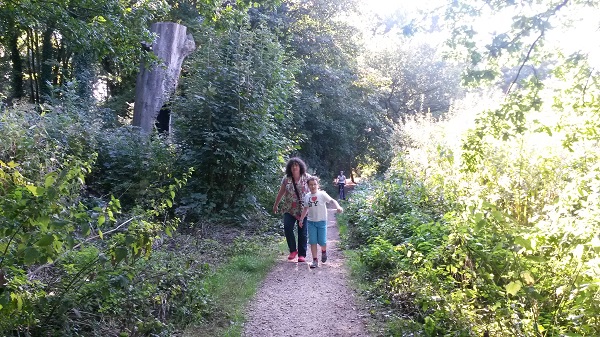Why is it important to act?
Green infrastructure is multi-functional and provides a wide range of benefits for local communities1

Credit: Climate UK
On this page:
Benefits for communities
Multiple policy objectives can therefore be tackled creating ‘win-win’ outcomes for local authorities and their partners in service delivery. A practitioner summary of multi-functional benefits from trees is available from Mersey Forest2. It sets out the benefits associated with health, adaptation, mitigation and economy. More detailed economic analysis of benefits has been carried out elsewhere, e.g. by Natural England3.
Green infrastructure provides a way to reach people in communities which are difficult to engage or where the adoption of other measures may be difficult. Community-level initiatives may be particularly important where it is less possible to use property level protection measures or where people are difficult to engage.
Green infrastructure is seen as a core and integral part of policy and practice at national and local scales and not an ‘added extra’. Central government considers ecosystem services to be central to the process of delivering on a range of objectives associated with sustainable development, adaption and impact assessment4. Measures are therefore relevant for local plans, policies and guidance. A partnership approach is also encouraged by government in order to meet the multiple objectives with which green infrastructure and related ecosystem services are associated, e.g. through the community infrastructure levy, section 106 agreements (through which planning is aligned with wider policies5) and environmental impact assessments6. Other environmental legislation is also relevant to green infrastructure7,8.
Duties and responsibilities
Local authorities have statutory duties and a range of other responsibilities to help build resilient communities. Green infrastructure initiatives and the functions that they provide can help deliver wider goals of building healthy communities and redress inequalities between people and places. More information about some of the relevant legislation can be found in the presentation Why climate justice matters and also in the links below. A 2013 briefing document from the Royal Town Planning Institute (RTPI) identifies links between green infrastructure and the planning systems in England, Scotland, Wales and Northern Ireland:
- Health and Social Care Act (2012) See People in poor health
- Localism Act (2011)
- Equality Act 2010 See People in poor health and Older people
Green infrastructure is one of the elements of building community resilience which is strongly related to the planning system. The National Planning Policy Framework 2012 (NPPF) and related National Planning Practice Guidance contain a set of statutory duties and policy links. A core element of the framework is the ‘presumption in favour of sustainable development’ and the requirement to guide development so that it provides social, environmental and economic benefits. Part of the remit is to provide high quality homes, support community health and wellbeing and help to deliver mitigation and adaptation to climate change. More information on the National Planning Policy Framework and Planning Practice Guidance can be found at this DCLG online resource and within the presentation Why climate justice matters.
References
- UK National Ecosystem Assessment publications
- The Mersey Forest Little Book of Messages
- Natural England (2014) Microeconomic Evidence for the Benefits of the Investment in the Environment 2
- Defra (2010) What nature can do for you: A practical introduction to making the most of natural services, assets and resources in policy and decision making
- DCLG (2006) Planning Obligations: Practice Guidance
- Jones, S. and Somper, C. (2014) The role of green infrastructure in climate change adaptation in London. The Geographical Journal, Vol. 180, No. 2, pp. 191–196
- Chartered Institution of Water and Environmental Management (CIWEM) (2010) Multi-Functional Urban Green Infrastructure: Briefing Report
- Natural England (2010) ‘Nature Nearby’ Accessible Natural Greenspace Guidance

Built by:

© 2014 - Climate Just
Contact us
